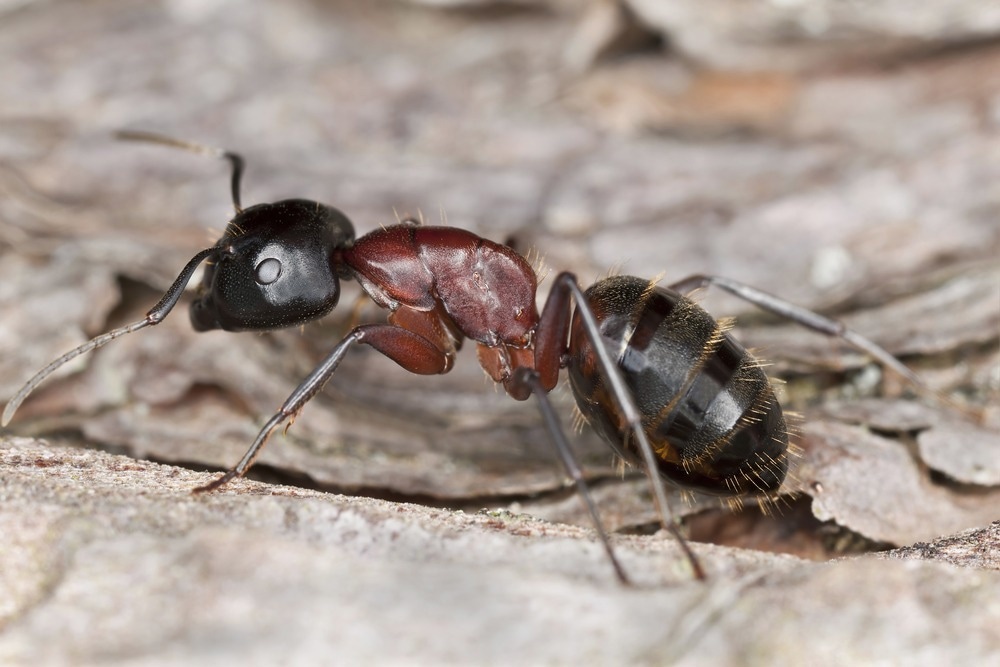 By Neha MathurReviewed by Danielle Ellis, B.Sc.Sep 29 2023
By Neha MathurReviewed by Danielle Ellis, B.Sc.Sep 29 2023In a recent article published in Nature Communications, researchers used Camponotus fellah (carpenter ants) as a model species to perform behavioral tracking and ribonucleic acid-sequencing (RNA-seq) to study the transcriptome-level differences between socially isolated workers versus workers in groups.
 Study: Social isolation shortens lifespan through oxidative stress in ants. Image Credit: Henrik Larsson/Shutterstock.com
Study: Social isolation shortens lifespan through oxidative stress in ants. Image Credit: Henrik Larsson/Shutterstock.com
Researchers explored the detrimental effects of social isolation on the behavior and lifespan of organisms, especially eusocial insects.
Background
Ants, termites, and some lineages of bees and wasps are eusocial insects and serve as appropriate model species to study the effects of social environments.
Studies have documented several detrimental effects of social isolation, such as reduced lifespan, diminished immunity, disrupted sleep, and metabolic dysfunctions.
For instance, in C. fellah, workers isolated from the queen or brood have shorter lifespans. Social isolation also affects their behavior; consequently, they show increased motor activity, the tendency to stay in peripheral regions of the foraging arenas, and imbalanced energy intake and expense.
Studies have also shown that digestive processes directly mediate the effects of social isolation. For instance, Formica ant workers in groups retain labeled food longer, likely because they exchange food. Furthermore, studies have shown that social isolation affects the expression of genes related to immune function and stress response.
About the study
Recent advancements have facilitated genetic and pharmacological manipulations in social insects. Thus, in the present study, researchers used four-month-old workers for RNA-seq analysis distinguishable via a unique color code, and those older than seven months for quantitative reverse transcription-polymerase chain reaction (qRTPCR), reactive oxygen species (ROS) quantification, survival tests, and behavioral analysis with antioxidants.
All minor workers used for study experiments had body sizes less than eight millimeters (mm) and originated from Queenright colonies reared in groups of 10 or alone. The experimental design controlled for age, social environment, and genetic background to prevent the effects of these factors on ants' behavior and physiology.
Next, the researchers extracted ribonucleic acid (RNA) from ants' cells and tissues (whole body) and assessed its integrity using a nanodrop 1000 spectrophotometer and a Bioanalyzer. Next, they used ants' RNA to create the complementary deoxyribonucleic acid (cDNA) libraries suitable for sequencing via an Illumina HiSeq machine that generated single-end sequencing of 100 base pair (bp) reads.
Then, the researchers moved on to creating a reference genome assembly and annotation for C. fellah ant spp. They also examined evolutionary relationships between different ant genes, a process referred to as phylogenic analysis. Specifically, they analyzed CYP clan 3, a group of genes encoding cytochrome P450 enzymes. Notably, in-group and isolated ants differently expressed these two genes.
Results
Similar to the observed links between social isolation and oxidative stress in Drosophila and rodents, in this study, the researchers noted that social isolation led to changes in the expression of oxidoreductase genes encoding oxidoreductases, enzymes that catalyze oxidation-reduction reactions. It led to the accumulation of ROS, particularly in the fat body and hepatocyte-like cells of C. fellah called oenocytes.
Studies have implicated insect oenocytes in various aging-related processes, including ROS production, energy metabolism, biosynthesis of pheromones, and systemic inflammation.
Further, results showed that genes implicated in ROS production and detoxification varied across different ant tissues, leading to oxidative stress, a state of imbalance arising from more ROS production than the body's ability to detoxify them. Clearly, oxidative stress plays a crucial role in aging and senescence in social insects
In this study, social isolation did not alter the expression of immune system-related genes but pathways related to modified amino acid binding and transporter activity. The inability of isolated ants to perform trophallaxis, i.e., food/fluids exchange within nest members, and impaired digestion affected their physiology beyond their immunity.
While in vertebrates, melatonin hormone regulates circadian rhythms, in invertebrates, it shows antioxidant properties. The researchers examined the effect(s) of melatonin supplementation in socially isolated ants and found it increased their lifespan but did not affect in-group ants. Similarly, nicotinamide adenine dinucleotide (NAD), another antioxidant compound, increased the longevity of socially isolated ants.
Antioxidant supplementation did not affect isolated ants' speed but significantly reduced the time spent near the wall and fully rescued their pattern of space use. Ant workers spending the most time near the periphery/wall of their enclosures had the highest levels of ROS, implying space use is a biomarker of social isolation-induced stress.
Another intriguing aspect of this observation was that melatonin treatment cleared ROS from the fat body and oenocytes of ants but did not affect ROS levels in their head and digestive tract. Previous studies have made similar observations in mice, where social isolation reduced their exploratory behavior.
Conclusions
Overall, the current study remarkably demonstrated the adverse effects of social isolation on gene expression, behavior, and longevity of C. fellah ants. The results showed that increased oxidative stress in the oenocytes and fat body mediated the social isolation-triggered adverse effects. The study data provide insights into how social perturbations affect the health and longevity of all eusocial organisms.